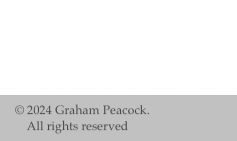 |
 |
||||
Abstract look at Canadian Prairies has been feather in Peacock's capThe Edmonton Journal. January 30, 2009 Flying into Edmonton to take up a lecturing position in at the University of Alberta in 1969, Graham Peacock was startled to see the vista below. "It was a small settlement with a single tower," he says. "As we got closer, I could see the tower was a grain elevator. On landing, I immediately took a cab to the university to see if I had indeed landed in the sticks. "I was pleasantly surprised. The smaller community I discovered was Leduc. It was pretty small back then." Thousands of students, academics and friends, and a band, are glad he found the size of Edmonton to his liking. London-born Peacock, 23 when he arrived, found the city supportive of arts. In 1986, he became a full professor in the U of A's Fine Arts department. Peacock is an abstract painter whose work hangs in public and private collections around the world. Harvard-trained art critic and writer Kenworth W. Moffett says Peacock has developed a highly involved painting procedure that generates new expressive textures, colours and forms. "I think of him as a mad alchemist turning plastic into gold," says Moffett. Roald Nasgaard, writing in Abstract Painting in Canada, says Peacock's work stands out as "some of the most original paintings to emerge out of the last four decades of abstract paintings on the Canadian Prairies." Nearing the end of his 40-year teaching career, Peacock can be as colourful as his work. He has a relatively private life away from teaching and work, but plays drums with professors who play every month in a Faculty Club bar. I still play the old set of wooden white pearl Premier drums I acquired in London from a jazz drummer in the early 1960's," he says. Peacock is presently on leave, and it's just as well. With various grants, and with a dig into his own pocket, he is taking delivery of 1,000 copies of his book, Graham Peacock: A Retrospective. "The idea for the book came during an exhibition of my work at the Art Gallery of Alberta in 2005," he says. "But it's a heavy book. It's difficult to find an economically viable way of sending it to galleries and collectors overseas who have expressed an interest in it." The hardcover book is like a 400-page catalogue of the artist's work between 1982 and 2007. It features more than 400 colour prints. Peacock discusses his painting process, accompanied by critiques and essays. (The book can be purchased for $125 at peacock@shawbiz.ca.) "My childhood love of art grew during the time spent at St. Jude's Primary school where, inspired by pots of thickened paint, I was content to paint for hours," says Peacock, who enjoyed drawing and painting with his mother. "We lived on the lower floor of a three-storey row house that had a small front garden. A neighbour kept a greenhouse in the back and kindled my love of gardening. "I learned by watching him and admired the different colours and varieties of plants he grew." In 1956, at the age of 11, he attended a comprehensive school and studied art from the third year on. He began working from life, doing clothed studies, still lifes and imaginary compositions. "I also made ceramics, furniture and carved wooden sculptures," says Peacock. "In art history, we wrote about and copied the great painters whose works were on view in the London galleries." In 1962, at the age of 17, he began his first year at London University's Goldsmiths College of Art. His parents had moved into a council house near Lambeth Bridge, close enough for him to walk to the Tate and National galleries. "It amazed me how much my taste expanded by seeing all the exhibitions and permanent collections," he says. In his second year, when he was singing, playing drums and harmonica with a blues band, he became his art schools' social secretary and visited clubs to select acts. "Sonny Boy Williamson was a resident at my favourite club, The Marquee Club," he says. "The resident band was the Yardbirds. "Bands I booked included The Who, the Moody Blues and The Kinks." Peacock went on to Leeds College of Art as a postgraduate student and then, at 21, taught at Newport College of Art. He found his teaching load left him little time to paint, and moved on when he gained an Italian government scholarship to Rome. "There I met Prof. Jon Knowlton, a painter from Yale on leave from the University of Alberta," says Peacock. "The U of A was expanding its Bachelor of Fine Arts program and searching for staff. Knowlton recommended me to Prof. Ronald Davey, an English art historian hired in 1966 to build and art and design program." The rest is history, as they say. "I'm very fortunate to have been allowed to explore my own visual sense and work with students," says Peacock. "An academic life has allowed me to be free in my art rather than concentrate on commercial success, not that I haven't enjoyed some. "I still love teaching. I believe art has a humanizing influence which can promote understanding. We're all different, but we all feel love, pain and hunger." |
|||||